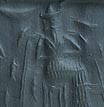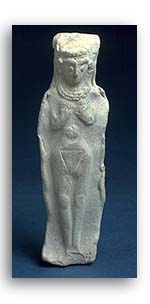
|
| Most of the cultures living in the ancient Near East worshipped many
gods and goddesses. Aspects of life were explained by the actions of these
gods - war, weather, disease, and more were understood as the result of
the gods' desires. People thought their gods looked and behaved like they
did, but with supernatural powers. Gods usually had beards and wore a
horned crown or helmet. They often had their own symbols, too - the crescent
and circle represented Sin, the moon god.
|
| How do we know about Near Eastern myths? Most of our information comes from clay tablets found in ancient palace and temple libraries. Scribes recorded myths in cuneiform writing. Also, we can see a lot of mythological stories, gods, and goddesses illustrated on cylinder seals. |  |
 |
For example, this impression of a seal shows the bird-man Zu brought for judgment before the Watergod. |
| The Near East was also the birthplace of three of the world's modern religions - Judaism, Christianity, and Islam. These religions are all monotheistic - they worship one god. |
 |
 |
 |
 |
 |
 |
 |
© Michael C. Carlos Museum of Emory University,
Memorial Art Gallery of the University of Rochester and Dallas Museum of Art
For more information please contact odyssey@emory.edu.
Last Update:
